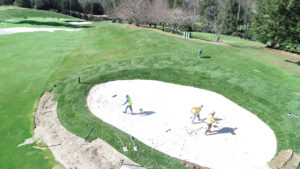The Cullsaja Club upgrades its bunkers with CapillaryFlow
Related Articles
The southern Appalachian mountains around Highlands, North Carolina, are a beautiful and desirable place to spend time, but can be an unforgiving environment in which to manage turfgrass.
The Cullsaja Club has called these mountains home since its foundation in 1989. The golf course, 4,100 feet above sea level, was created by Arnold Palmer Design, and is now a successful private venue, an escape from the hot summers of the surrounding towns and cities. Its season runs from May to October, and, according to course superintendent Tom Nelson, keeping the course in the best condition can be difficult.
“We have a very unusual microclimate here, a temperate rainforest,” he explains. “Typically, we get around ninety inches of rain each year. When storms come out of the south, they hit the mountains and dump the rain on us – it’s quite common for us to get four to six inches of rain at a time here, and that generally happens several times a year. And following those rain events, bunkers become quite a labour challenge. In the past, it wasn’t uncommon for me to have 90-100 man hours of work to get the bunkers back into shape after rain.”
Cullasaja renovated its original bunkers in 2004, with a lining system. “They worked well for the first ten years, but then they really started to deteriorate,” says Nelson. “So, given that we also needed to do some work on several of our greens, it was clear that it was time for a rebuild.”
The club hired Atlanta-based golf architect Bill Bergin to oversee the work, and chose to line the bunkers using the Capillary Bunkers technology supplied by CapillaryFlow. “A couple of courses in our area had used the Capillary technology, and I got some really great feedback on it from the superintendents,” says Nelson. “Also, I felt that, given the climate uncertainties up here, the ease of installation would be very helpful – our window of opportunity to get it down was going to be better. Bill has done a lot of work in the area, and he has a really good vision to make the course more playable for higher handicaps while increasing the challenge for the better players.
“We have redone three greens in this phase and will do three more in the next one,” says Nelson. “The greens are original and a mixture of poa and bent, and we wanted to keep that surface, so we have grown in new turf from our aeration plugs. We were constrained on nursery space, which forced us to phase the project. We’re also adding a lot of forward tees, and a few back ones.”
Cullsaja’s old bunkers featured a very high, flashed sand line. “The theory when we built them in 2004 was that if you took the sand to the top and had good drainage, they wouldn’t wash out. And they were pretty good at first, but they got progressively worse over time,” says Nelson. “Bill doesn’t typically flash the sand that high, but we‘re pushing him to take the sand line a bit higher. And, as well as the Capillary Bunkers liner, we are installing the Capillary Wash Box, which will enable us to extend the useful life of our bunker sand, saving even more money.”
Work started in mid-October and was wrapped up in the middle of April, ready for the course to open for the season on May 1. Landscapes Unlimited handled the build. “When we open, I think our members will really like the new look of the course,” says Nelson. “And I’m sure my crew will like the fact that they won’t have to spend so much time pushing sand up bunker faces after rain!”


























